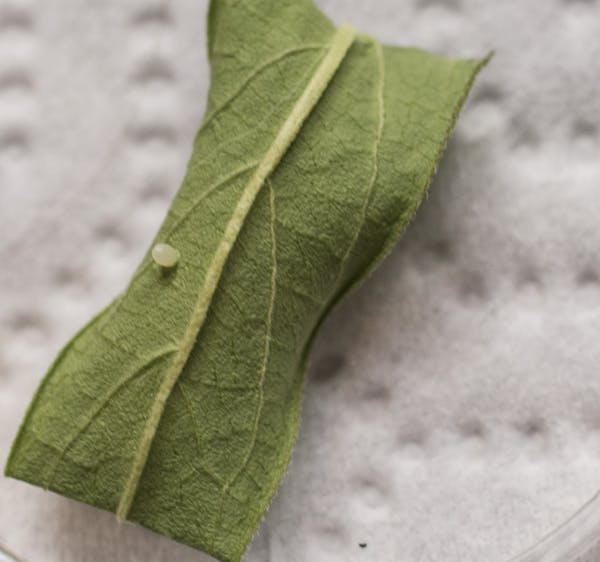Fiona Lennox is raising 400 picky eaters who demand a lot of attention.
That job is especially challenging because those picky eaters are monarch butterflies that will eat only one thing — milkweed.
Recently, as she's done every day since the monarchs arrived in Minnesota in June, Lennox, 49, went looking for the plant, which is often mowed down or weeded from urban landscapes without much thought. Her search took her through several blocks of south Minneapolis alleyways, weed-laden boulevards and neighbors' native gardens.
"I'm a mama," Lennox said. "I've gotta make sure my kids have the best outcome."
The quest for milkweed is also an egg-saving mission. In the wild, monarch eggs have less than a 10 percent survival rate, so to improve their chances of making it to adulthood, the Minneapolis woman collects their eggs, raises them in her home and releases them when they become butterflies.
The effort has kept Lennox so busy that she has taken a sabbatical from her job as a business consultant so that she can stay home and raise her orange-winged "kids."
"It would be sad to have the monarch as the state butterfly and not have the butterfly show up in your state," she said.
Lennox's monarch-rearing operation has taken over her home office, backyard and occasionally other areas of her home — when a caterpillar escapes its confines and is found crawling across the hardwood floors, for instance.
Ending up with hundreds of butterflies "wasn't the plan," she said. "Except when you keep finding them, how can you stop?"
Raising butterflies is more work than Lennox expected. What started with a few caterpillars in plastic salad containers quickly turned into a desktop spread of Petrie dishes, several screened butterfly boxes and an outdoor sanctuary made with tulle from Jo-Ann Fabric and Craft.
"It's turned into quite a production," she said. "It has become all-consuming."
Got milkweed?
Lennox estimates she spends half of every day caring for the insects. Each day, the caterpillars get fresh milkweed, which is imperative to the monarchs' survival. Monarchs lay their eggs on the plant; it's the only food the larvae can eat.
Tending to the milkweed alone is a tedious process that involves washing, rinsing twice and storing the leaves in Tupperware in her refrigerator. Then there are other duties: During the caterpillar stage, Lennox cleans their containers twice a day to keep bacteria at bay.
While looking for eggs recently in her Fulton neighborhood, she explained that alleyways are an oasis for milkweed because residents are less likely to chop it down or use pesticides.
"The alleyways are the most forgotten part of our city," she said.
Neighbors who know of her passion for monarchs deliver bucketfuls of plants they saved from being bulldozed at a construction site. Others offer Lennox space in their yards to grow milkweed or permission to inspect their plants for eggs.
"They say it takes a village to raise a child," Lennox said. "I'm learning it takes a city to raise monarchs."
Once the butterflies reach the metamorphosis stage, they spend about 10 days in a jade-colored chrysalis before emerging as a full-grown monarch butterfly. When their wings dry and they begin to fly, Lennox releases them as soon as possible.
This time of year, she is more diligent than ever in her search for eggs because the monarchs she releases now have a chance of making it to Mexico. Most monarchs live only for a couple of weeks before mating and dying, but the fourth generation, born in late August, will forfeit mating in order to migrate to Mexico.
The butterfly effect
Advocacy is a big part of Lennox's mission. She tries to educate everyone she meets about the need for milkweed and pollinator plants that are grown without pesticides.
While walking the alleys in search of monarch eggs recently, Lennox stopped to talk with neighbor Mary Ellen Halverson, 75, who had a single milkweed plant sprouting in the center of her lawn.
"She came to my window one day and said, 'I'm here to ask for amnesty for the milkweed in your yard,' " Halverson said, bending down to inspect the underside of its leaves for eggs. "So now I mow around it."
Neighbor Keli Ferrier has an organic flower garden, an oasis for monarch butterflies. Lennox asked Ferrier, 44, if she could inspect her milkweed for eggs and taught her how to collect them herself. Ferrier now searches her yard and those around her for milkweed and delivers swatches of egg-laden milkweed leaves to Lennox nearly daily.
"Her eyes were sparkling when she asked me," Ferrier said. "How could I say no?"
Citizen scientists
Lennox and her neighbors' efforts seem to be working. By some estimates, the monarch population has declined by more than 90 percent over the past 20 years. Last year, Lennox released 30 butterflies all summer. This year, she's at 400 and counting.
"I see them now and I wonder, 'Is that one of mine?' " Lennox said.
Karen Oberhauser, a University of Minnesota conservation biologist and monarch expert, said the work done by private citizens such as Lennox is boosting the butterfly population.
"I've called citizen scientists an 'army for conservation' for many reasons: They collect data with conservation applications; they often become stewards for local habitats, and they reach out to others about the importance of conservation," Oberhauser said.
Lennox hasn't received a paycheck in nearly a year.
"Leaving my job has allowed be to be crazy with all these little critters, feed them and tend to them for hours a day," she said. "Damn the salary, I just gotta do what I love."
She hopes to turn her love for butterflies and the environment into a new career in nature conservation. Until then, she'll tend to her "babies" until the last one flies south.
And then?
"I won't know what to do with my days," Lennox said. "I'm going to have empty-nest syndrome."
Aimee Blanchette • 612-673-1715
Visa fees for international artists to tour in the US shot up 250% in April. It could be devastating

Executor of O.J. Simpson's estate plans to fight payout to the families of Brown and Goldman

